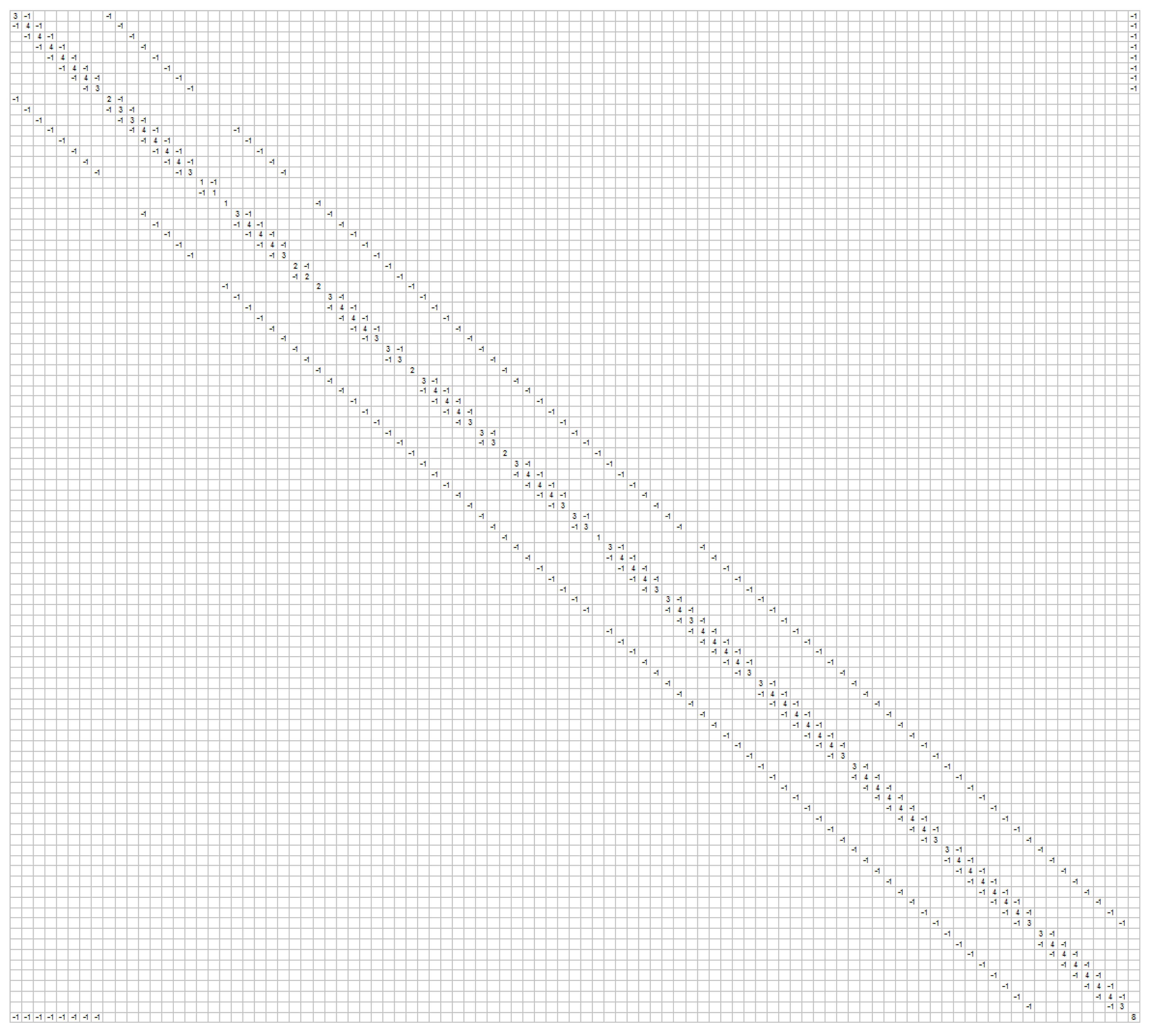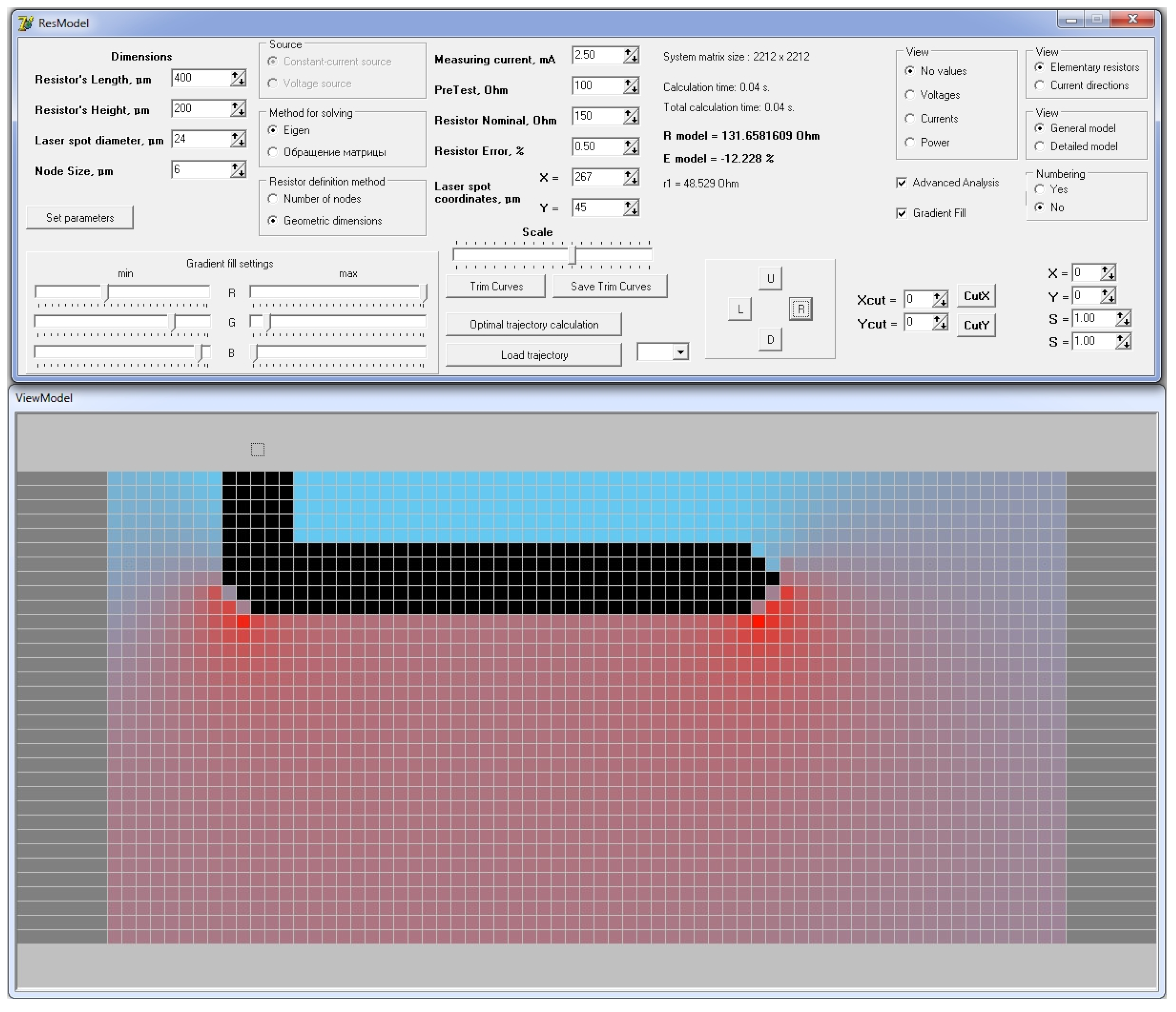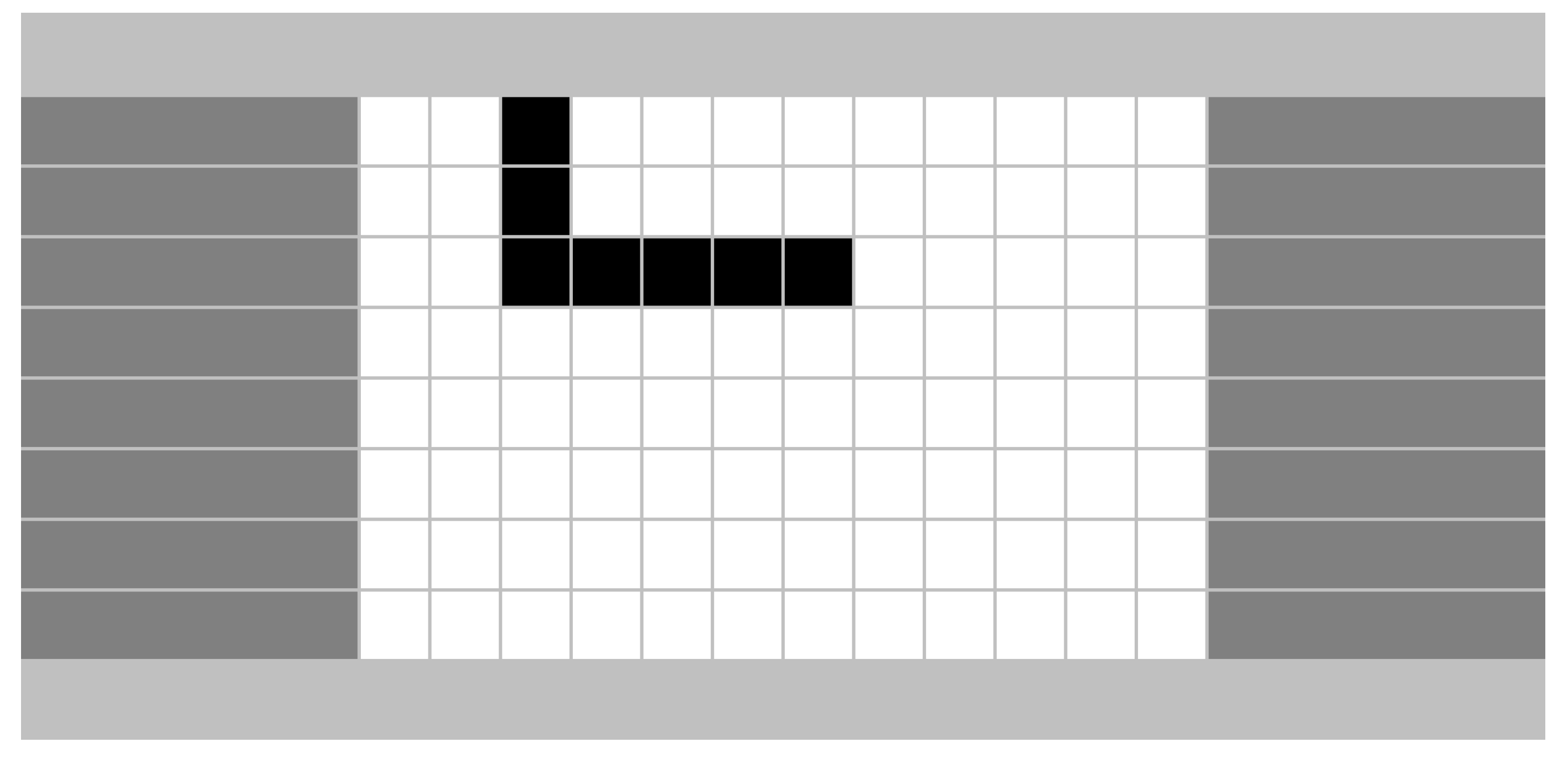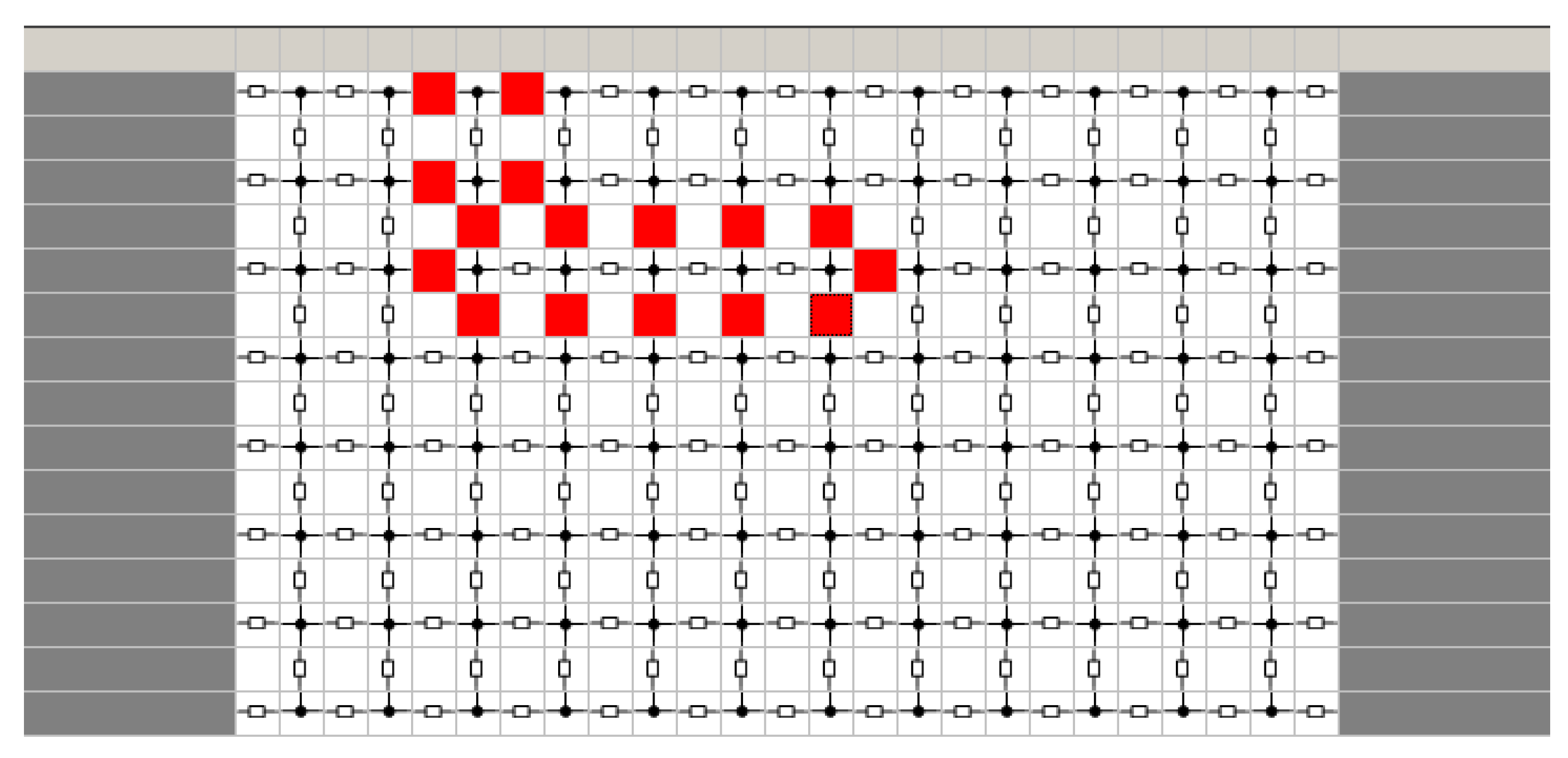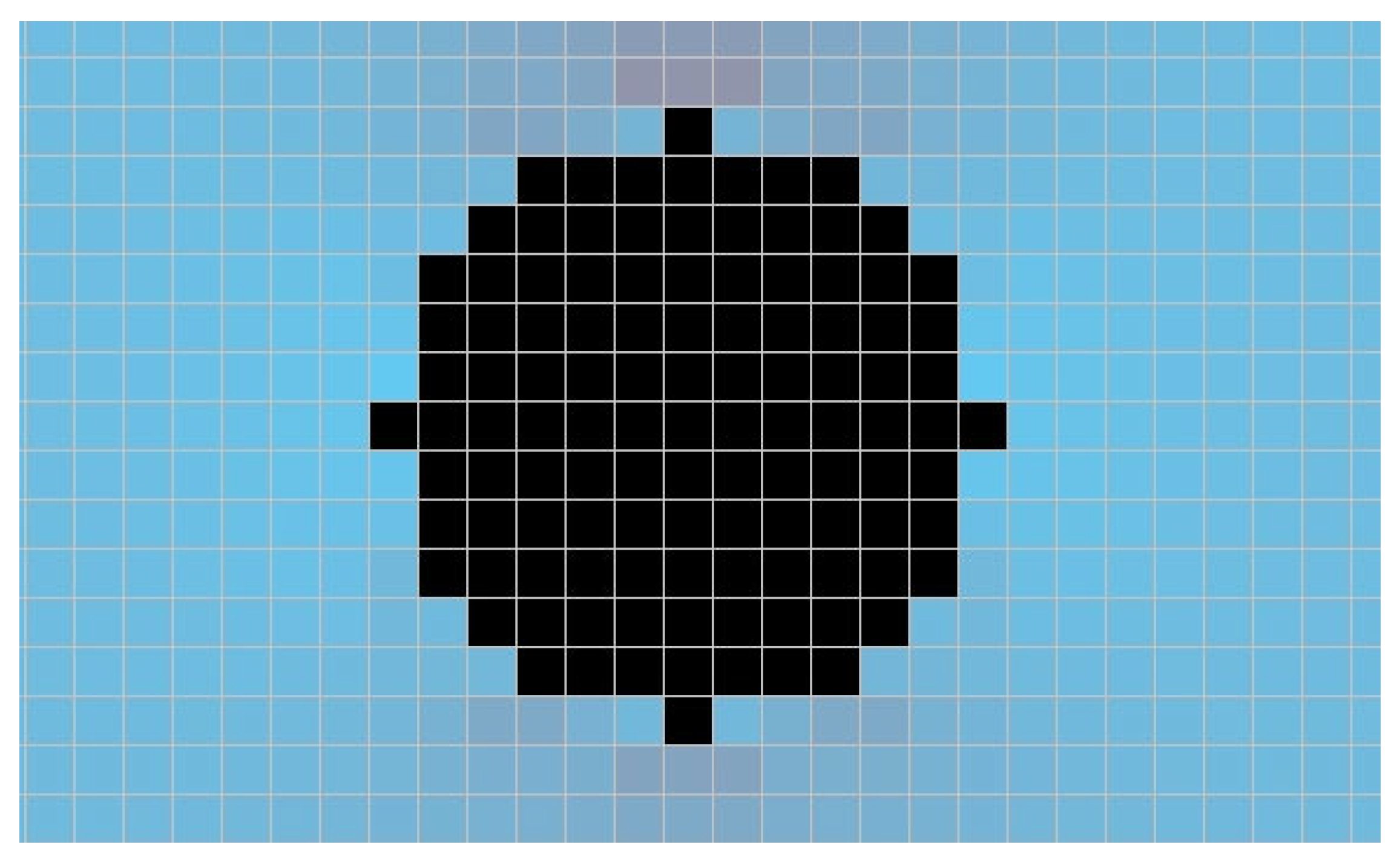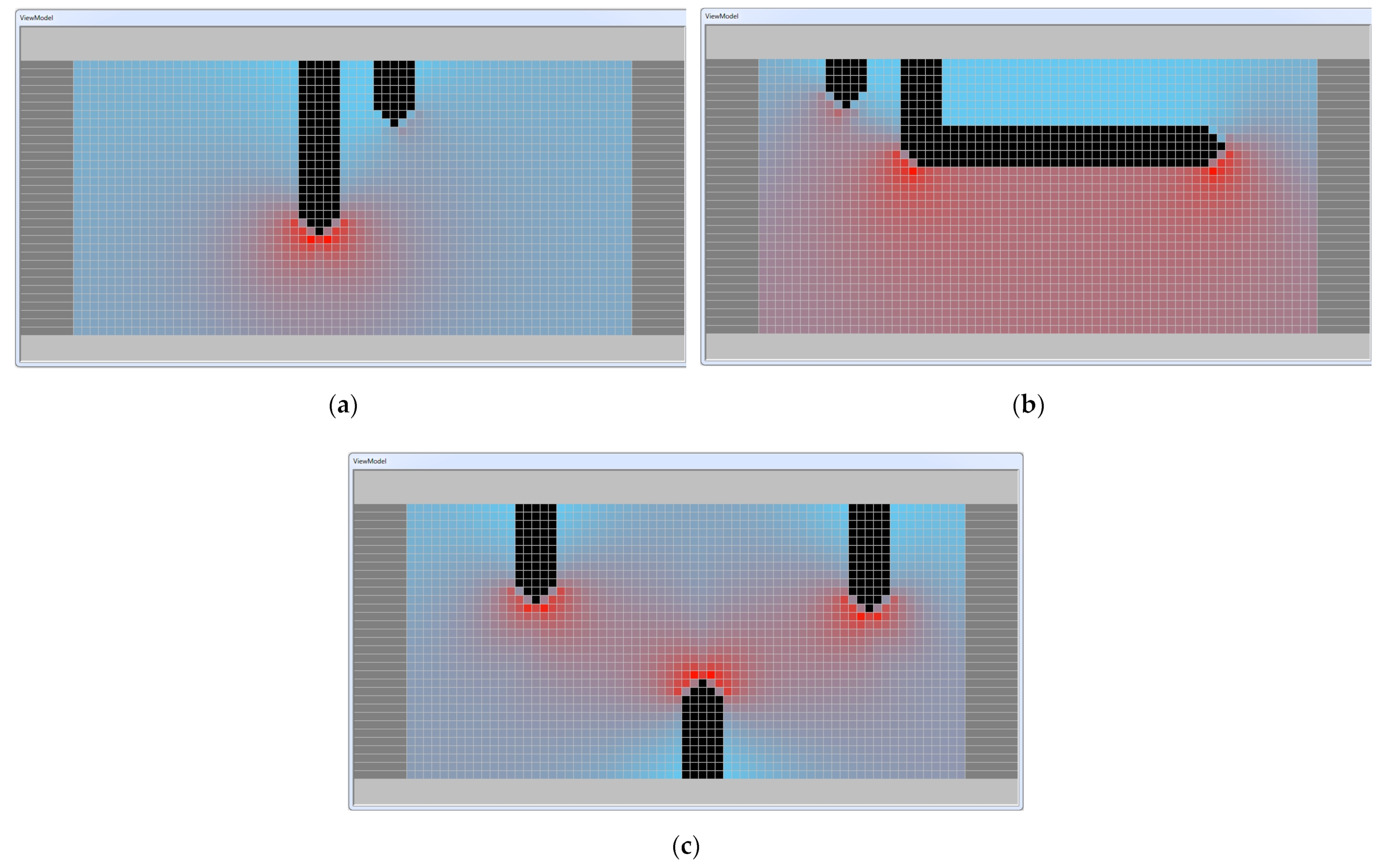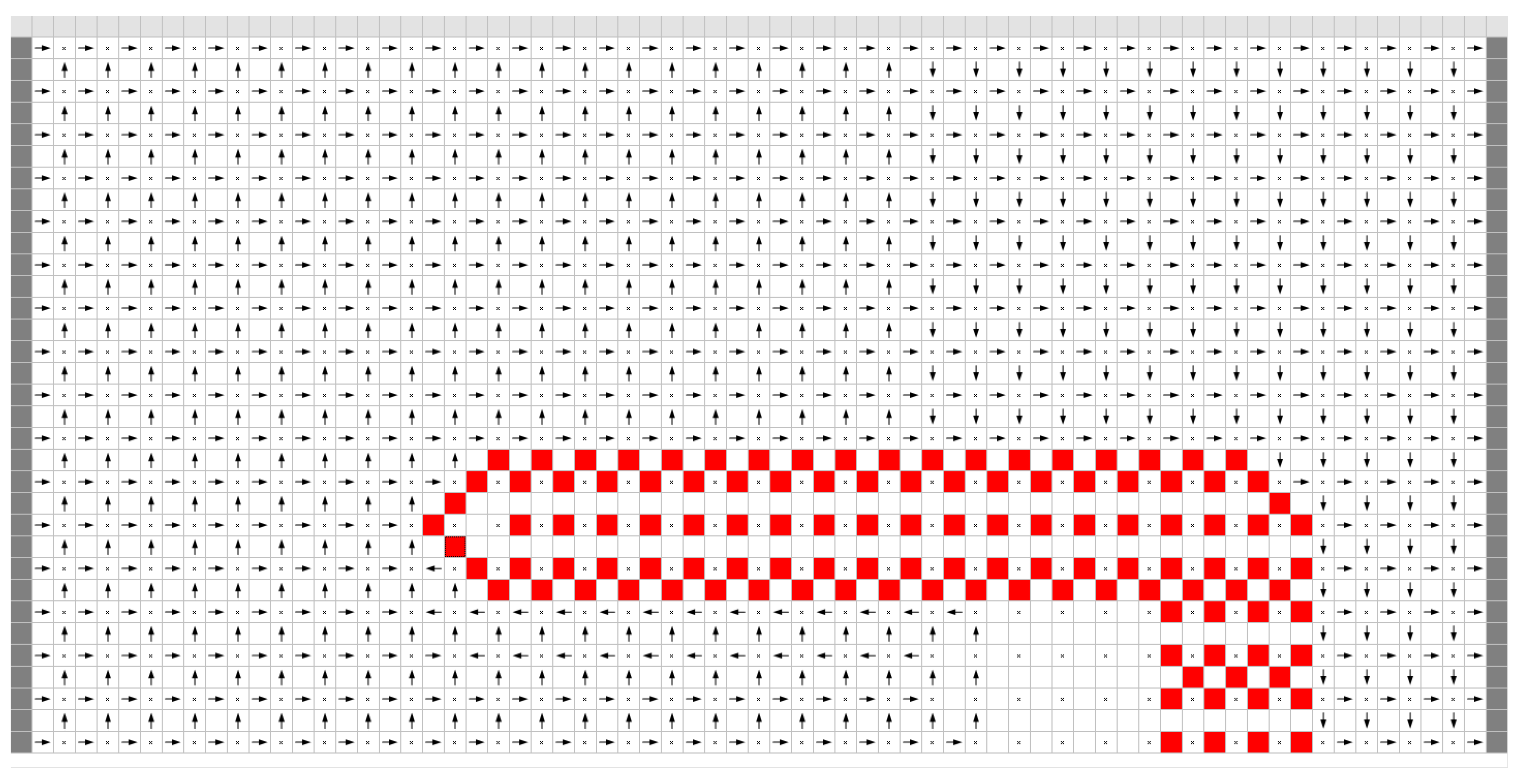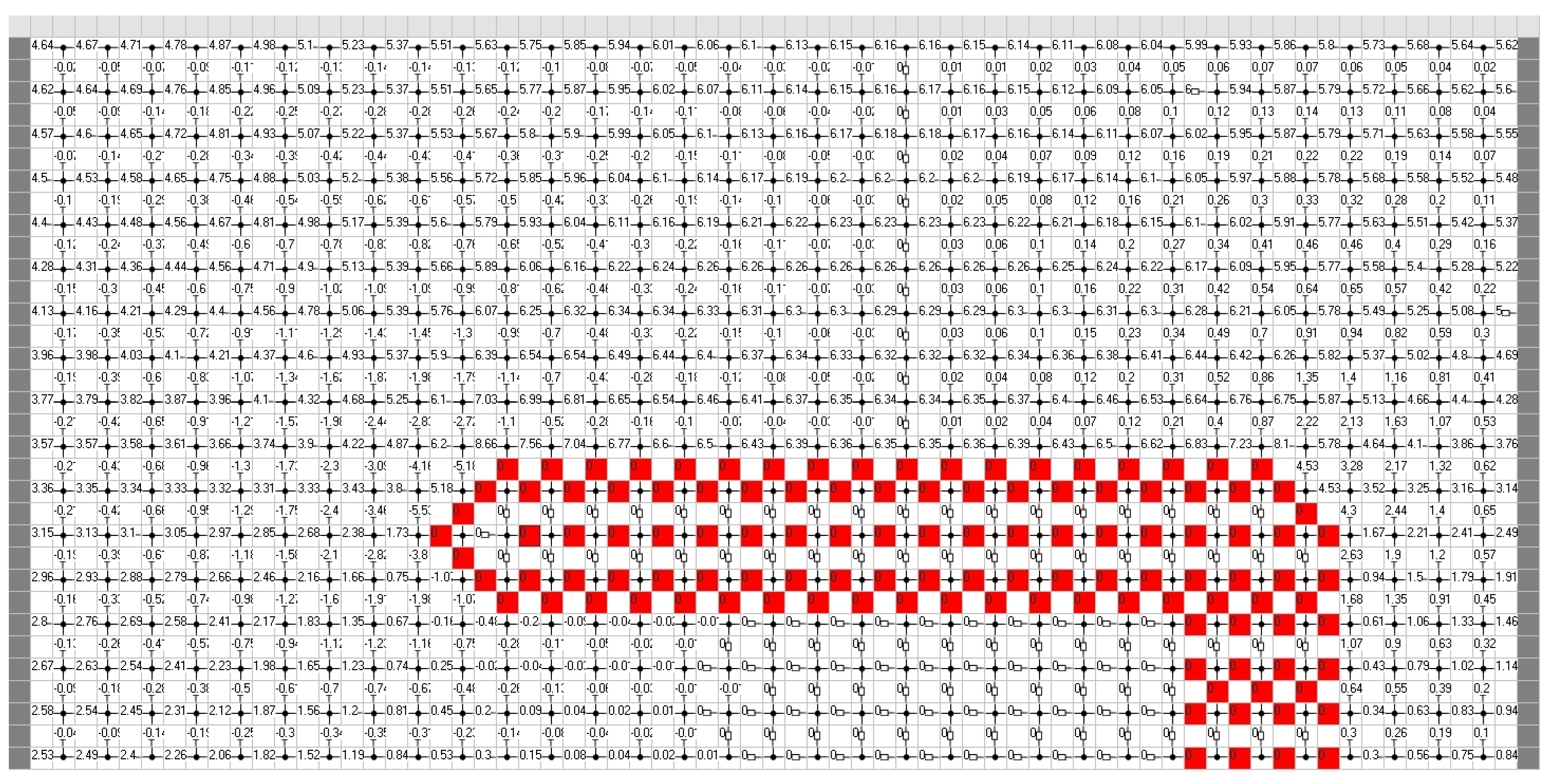1. Introduction
Any changes to manufacturing equipment or processes require test runs and final product testing. The equipment and the control logic are then fine-tuned, and the tests are repeated. This is the manufacturing process adjustment cycle. When the changes are significant, the process adjustment may be quite challenging both in terms of efforts (making test parts, running a pilot process, acquiring and analyzing the results) and the cost of consumables spent [
1]. Moreover, it is often difficult to identify which process variable or equipment component affects the result.
For this reason, simulation software is required to assess the models, adjust the algorithms, and better investigate the distribution of resistive elements (RE) electrophysical parameters. It should be used before actually implementing the models of film or foil resistors proposed and described in detail by us [
2,
3], into the control systems of actual laser machines. Please refer to [
2,
3] for a detailed description of the proposed models.
There are many studies on the simulation of film and foil resistors, laser trimming, and dedicated simulation software.
Some of the film resistor simulation papers are of special interest. Wing Shan Tam et al. [
4] investigate the adjustment of a composite resistor’s resistance by breaking the linked fuses. Phillip Sandborn and Peter A. Sandborn [
5] present the options for emulating the trimming process with conductive paper and comparing the results with the simple analytical methods (the rectangle method) and giving the resistance vs. length of laser trim curves (the so-called resistor trimming curves, RTC). Sandborn, P. et al. in [
6] present a detailed finite difference model of the film resistor and discuss the optimal trim paths for achieving the specified resistance in detail. The optimization criteria are the length of the trim and the final resistance accuracy. The paper also contains examples of the current load analysis over the entire resistor. We should also note that paper [
6] compares the results of the trim simulation with the conductive paper experiments.
V. Sadkov, A. Pilkevich, K. Fomina, and E. Korshunova [
7,
8,
9] extensively covered the conformal map-based simulation of resistors, absorbing elements, and embedded attenuators exposed to HF and UHF signals. A. Pilkevich et al. [
10] confirm the results obtained with the proposed simulation methods. They compared the results with that produced by a general-purpose FEM simulation package for EM, thermal, and mechanical processes [
11]. A. Walton, R. Holwill, J. Robertson [
12], M. Horowitz, and R.W. Dutton [
13] solved similar resistor simulation problems at microwave frequencies. Van der Woerd et al. [
14] present a mathematical model and the results of computer calculations of resistance with Green’s boundary functions. M. Rubanovich, N. Aleksandrov, V. Manusov, and V. Khrustalyov [
15] simulated the EM properties of film RE. They performed FEM and nodal stress calculations to determine the distribution of capacitance and inductance values along the cross-section of the film resistor. Matlab 2010 and the SimPowerSystems (SPS) library for Simulink were used for the numerical estimation of currents and voltages. The results produced by the proposed EM simulation model are confirmed by the electrodynamic calculation of the imaginary and real parts of the film resistor impedance performed with the Microwave Office.
The following works cover the development or application of resistor trim simulation software. Michael J. Mueller and Wes Mickanin [
16] present the RAREA simulation results. The software calculates the resistance using the method of least squares. The software was written in Pascal and run on the RSTS, VMS, and Unix operating systems. RAREA can also design the RE configuration from the specified requirements for its geometry and properties. T. Mitsuhashi et al. [
17] developed the RCALC simulator with the appropriate capabilities.
Papers [
18,
19,
20] present the FIRE and SCANRES film resistor simulation packages. They evaluate the effect of the heat-affected zone (HAZ) around the laser cut on the accuracy of the expected resistance value. Among others, the packages estimate the relative dissipated power density over the entire resistor film. J. Shier. [
21] gives a detailed overview of FEM applications to film resistor simulation. The author also presents a dedicated code in Basic. G. Papp in [
22] gives a detailed description of the finite difference method and the simulation results as the software reports. They clearly show the resistance values and the current and power dissipations. P. Moran et al. [
23] present the mathematical model and give a detailed description of the software features and capabilities for evaluating the resistance, the resistance sensitivity to trims, and the magnitude of local “hot spots”. They also give a case example. It should be noted that K. Schimmanz, A. Kost, and S.M. Jacobsen in [
24,
25,
26,
27] provide not only a detailed description of FEM, finite difference, and boundary element-based approaches but also compare the results in terms of accuracy and performance. Paper [
28] presents an extensive list of parameters affecting the simulation results. They are the key properties of the RCutSim trim simulator developed by the paper’s authors. We also should mention a number of in-depth studies that resulted in the development of trim resistance estimation software or a full-fledged mathematical model [
29,
30,
31,
32].
The authors of [
6,
10,
12,
15] used general-purpose simulation software. S. Kaminski, E. Mis, M. Szymendera, and A. Dziedzic used ANSYS [
33,
34] to develop the new resistor configurations (with three pads) and laser trims. They also compared the simulation results with the actual trimming on the Aurel equipment [
35]. The authors applied conformal mapping for calculations and claimed the results agree well with the FEM results. A. Manolescu et al. [
36] used Matlab to estimate the resistance also using conformal mapping.
Some researchers give simulation results as predicted resistance values, current distribution diagrams across the resistor film, trim curves, or statistical values but do not specify what models and software they used. Studies [
37,
38] investigate the optimization of trim cut configurations. Y. Antonov [
39] gives examples of analytically estimated resistance values compared to that of the trimmed RE [
40]; J. Skácel [
41] describes the prediction of the thick film resistor trimming.
Unfortunately, a large number of studies presented above contain a description of the solution of only a narrow specific problem, whether it is the construction of a resistor model or the development of a simulation program. Apparently, the authors of these works did not set the task of an integrated approach to automating the process of laser trimming and embedding models and algorithms in equipment. In addition, the authors of most studies, for all the undoubted significance of their work, either do not study the obtained models for accuracy (there is no comparison of the simulated value in the simulation system with the real values of the resistance of the trimmed resistors) or do not provide data on the efficiency of the calculation algorithms for the proposed models. Additionally, a number of researchers do not provide a description of the construction of the model, and, therefore, it is not possible to assess which of the methods was used.
Our detailed analysis of the above studies identified the need to develop a laser trimming simulation software to be used before embedding the existing models and algorithms [
2,
3] for calculating the electrophysical parameters of resistive films into the industrial equipment software. Such a system will enable the flexible modification and fine-tuning of the algorithms, a preliminary analysis of the model accuracy and adequacy, and studying the features of various resistor configurations. Additionally, a detailed description of the software structure and implementation of the existing models and algorithms will hopefully help researchers and engineers in this area with using and analyzing the results of this study.
This article has the following structure. The Introduction presents the prerequisites for this particular work within the framework of the general series of articles, analyzes the available literature, highlights the advantages and disadvantages of known works and approaches, presents the purpose of the work, and also provides the structure of the manuscript.
Section 2, “The ResModel Software”, proposes a method for implementing the ResModel software based on the models and algorithms developed by the authors and provides a detailed internal structure of the program, as well as hardware requirements.
Section 3 contains an example of the program with a detailed presentation of internal variables, as well as initial data and simulation results.
Section 4 describes in detail the features of the software implementation of the representation of the laser spot, gradient filling, as well as solving systems of linear algebraic equations.
Section 5 contains the results of the simulation modeling of the process of trimming a resistive element with various types of trimming cuts in order to illustrate the capabilities of the developed software.
Section 6 discusses the results obtained.
Section 7 gives an idea of the next steps of the research.
3. ResModel Operation
To better present the main variables and arrays, we will consider an example: a trimmed resistor with the parameters listed in
Table 3. At the same time, the dimensions of the resistor for demonstrating the operation of the software were chosen as close as possible to one of the smallest types among chip resistors—01005 (dimensions 0.4 mm × 0.2 mm). However, if a length of 0.4 mm were chosen, then the dimensions of the arrays Arr1, Arr2Br, Arr3Node, Arr3NodeI given later in this article would be higher, which would negatively affect the visibility of the information. The diameter of the laser beam spot was taken based on the technological requirements for microminiature resistors and the capabilities of modern equipment for laser trimming. The node size NodeSize is equated to the diameter of the spot, again for the sake of clarity of the matrices. The electrophysical parameters of the resistor in this example are chosen arbitrarily and do not have any effect on the contents of arrays Arr1, Arr2Br, Arr3Node as illustrations of the internal structure of the software.
The resulting resistor model is shown in
Figure 2 (general view) and
Figure 3 (detailed view). At the same time, in both views, the dark areas located on the left and right imitate contact pads; above and below the body of the resistor are sections of the dielectric substrate. The trimming cut itself in
Figure 2 is depicted in black on a white field of resistive material. In
Figure 3, the trimming cut is depicted in red in more detail, illustrating which elementary resistors are removed from the grid circuit model when forming the general view of the cut in
Figure 2.
The dimensions of the arrays are listed in
Table 4. The table also contains the main characteristics of the internal model representation.
The Arr1 array is shown in
Table 5.
This matrix is intended to provide an internal representation of the grid circuit model in detail (as shown in
Figure 3). Row 0 and column 0 store ordinal numbers and are omitted as trivial here and in some of the following matrices where they are used in the same way. The node numbers are stored at the intersections of odd-numbered rows and even-numbered columns. The cells at the intersection of even-numbered rows and columns, and odd-numbered rows and columns, contain one if there is a branch and zero if the ER corresponding to the branch has been trimmed. All the other cells are zeros.
The Arr2Br matrix contains the numbers of branches at the intersections of even-numbered rows and even-numbered columns and odd-numbered rows with odd-numbered columns. The unused cells are zeros. The Arr2Br matrix for the example under consideration is shown in
Table 6. Both the Arr1 matrix and the Arr2Br matrix are needed in general to ensure the end-to-end numbering of nodes and branches in accordance with the requirements for the nodal analysis method based on topological and component equations, which was described in detail in previous articles of the cycle shown in
Figure 3 in [
2],
Figure 3 in [
3].
The Arr3Node array is filled by sequentially analyzing the grid nodes using the information contained in the Arr1 matrix. If the number of “live” (conducting) branches connected to the node is greater than one, then the node is considered operational, and the corresponding matrix cell is set to one. Otherwise, it sets to zero.
Each cell of the Arr3NodeI array is filled only if the corresponding cell of the Arr3Node array contains one. The value stored is equal to the sum of the absolute currents in the branches adjacent to the node. If a node is not operational (the Arr3Node matrix contains zero in the corresponding cell), then the cell is also set to zero.
The Arr3Node and Arr3NodeI matrices for the ResModel simulation example are shown in
Table 7 and
Table 8, respectively. In the course of the program, these matrices serve as data storage for displaying the distribution of the current load over the sections of the resistive film.
The
system matrix is filled as previously mentioned in
Section 4 in [
2] and
Section 4 in [
3]. It contains the system structure (6), (11), and the number of nodes to which the resistor being trimmed is connected. If the
th branch with the
conductivity which connects node
to node
is added, the matrix
is adjusted at four places:
is twice added to the
и
elements of the
matrix diagonal, and
is twice subtracted from the
and
non-diagonal elements:
It reduces the required computer resources (time and memory) which would otherwise be required to create and handle the incidence matrix. Please refer to
Figure A1 in
Appendix A for the system matrix for this example. The incidence matrix is created when an extended analysis is needed, i.e., to calculate not only the resistance for a specific trim, but also the currents, voltages, and dissipated powers for all the ERs.
6. Discussion
The resistor trim curves produced by ResModel agree well with [
5,
6,
23,
27,
33,
34,
36]. The “hot spot” locations at the laser cut path and the current directions also correlate very well with [
18,
20,
27,
36]. The current load distributions presented in [
5,
6,
22,
33] are slightly different. We believe this is due to the visualization features of the specific simulator, not to any errors in the models.
The ResModel software not only verifies the models and algorithms for estimating the electrophysical parameters of resistive medium (thin film, thick film, or foil) but is also a valuable tool for studying the relationships between the resistor configuration and its performance such as the max power dissipation, resistance drift over time, etc. The proposed approaches to simulation allow us to calculate the final resistance after a certain trim and to investigate the distribution of current, voltage, and power over the ERs. In the future, this will enable the specification of the criteria important for resistor operation such as:
The above software features are extremely important to embed the proposed models and algorithms in industrial laser equipment for resistor trimming. The models are very versatile in terms of simulating resistors and trims of various configurations beyond those discussed in this paper.
In general, we consider the combination of the following factors to be the main novelty of the software developed and presented in this work. Firstly, this system has a wide functionality: calculating the resistance value for various types of trimming cuts and for various configurations of resistive elements, searching for optimal trimming trajectories according to one or another criterion, building trimming curves, determining the current load and power dissipation in any of the sections of the resistive conductive environment. Secondly, the ResModel software is a specialized tool for modeling the process of trimming film and foil resistors; this allows the use of computing tools tuned specifically to solve such problems, which provides a significant increase in speed and much higher visibility. Additionally, thirdly (and most importantly), despite the complete autonomy and independence of the developed software, its final purpose is to be integrated into the control system of industrial laser equipment for adjusting film and foil resistors. Indeed, if the user sets all the initial data for modeling (
Table 3 in the article under consideration) manually when used independently, then when embedded in a real control system, part of the data (geometrical dimensions of the resistor, diameter, and location of the laser radiation spot) will be received by the system using the optical system of the installation and machine vision algorithms, and the other part with the help of measuring instruments (ohmmeter or other measuring system).
We should also mention such critical characteristics of any simulation model as accuracy and performance [
53]. For a complete analysis of these characteristics, it will be advisable to simulate identical resistors in different software packages (dedicated and general purpose). The resistance simulation results should be compared to the resistance of actual trim resistors formed of various resistive materials and in the commonly used configurations. Such a model verification is highly relevant to meet the chip miniaturization and process automation trends. The next and final publication in this series will cover these criteria in detail.
